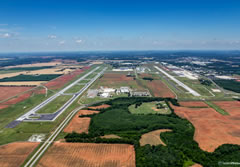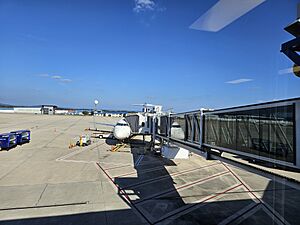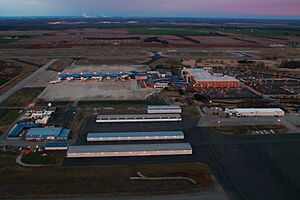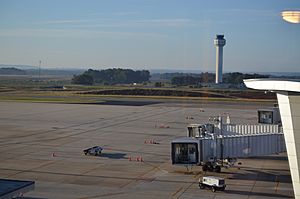Huntsville International Airport facts for kids
Quick facts for kids
Huntsville International Airport
Carl T. Jones Field
|
|||||||||||||||
|---|---|---|---|---|---|---|---|---|---|---|---|---|---|---|---|
 |
|||||||||||||||
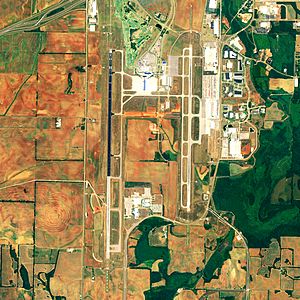
NAIP 2006 orthophoto
|
|||||||||||||||
| Summary | |||||||||||||||
| Airport type | Public | ||||||||||||||
| Owner | Huntsville / Madison County Airport Authority | ||||||||||||||
| Serves | Huntsville, Alabama | ||||||||||||||
| Elevation AMSL | 629 ft / 192 m | ||||||||||||||
| Coordinates | 34°38′14″N 86°46′30″W / 34.63722°N 86.77500°W | ||||||||||||||
| Map | |||||||||||||||
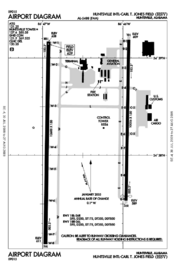 FAA airport diagram |
|||||||||||||||
| Runway | |||||||||||||||
|
|||||||||||||||
| Statistics (2024) | |||||||||||||||
|
|||||||||||||||
|
Source: Federal Aviation Administration
|
|||||||||||||||
Huntsville International Airport (also known as Carl T. Jones Field) is a busy public airport and spaceport located about ten miles southwest of downtown Huntsville. It is in Madison County, Alabama, United States. The FAA (Federal Aviation Administration) has chosen Huntsville International Airport as a special re-entry site. This means that the Dream Chaser, a spaceplane from Sierra Space, can land here after returning from space.
This airport is an important part of the Port of Huntsville. This port also includes a large shipping center and an industrial park. The airport serves the greater Huntsville and Decatur areas. It first opened in October 1967 as the Huntsville Jetport. It was the third airport built for Huntsville. The airport has 12 gates, which are places where passengers board planes. It also has restrooms, shops, restaurants, and cool murals showing aviation and space exploration. There's even a 3-star hotel right at the airport! The Four Points by Sheraton hotel is located above the ticketing area.
The airport has a very long west runway, measuring 12,600 feet (about 3,840 meters). This makes it the second longest commercial runway in the southeastern United States. It's only a bit shorter than the longest one at Miami International Airport. Because of its long runways and excellent equipment for clearing snow and ice, Huntsville is often used when big airports like Atlanta have problems.
The airport has a "Fly Huntsville" campaign to encourage people to fly from here. This helps them avoid driving to other airports like Birmingham or Nashville. In 2009, a report showed that flights from Huntsville were sometimes more expensive. However, the airport has seen a steady increase in passengers over the years. The Federal Aviation Administration considers it a primary commercial service airport. This means it's a major airport for passenger flights.
Contents
Airport History
Huntsville has had a few airports over the years. The very first one, called Huntsville Flying Field/Mayfair Airport, opened in the early 1930s. It was south of the city and had grass runways with no lights.
A second airport opened in 1941, also south of downtown. This one had two paved runways. The main building was a small wooden shack. You can still see traces of these old runways from the air today.
The current airport, Carl T. Jones Field, opened in 1967. It is located west of the city. A special opening ceremony was held in September 1968. Famous people like Dr. Wernher von Braun, a rocket scientist, and Senator John Sparkman were there. In 2018, Frontier Airlines started offering new flights to Denver and Orlando. This brought back more affordable flight options to the airport.
Airport Facilities
The airport covers a large area of 6,000 acres (about 2,428 hectares). It sits at an elevation of 629 feet (192 meters) above sea level. It has two asphalt runways. One is 12,600 feet long and the other is 10,001 feet long. In the year ending June 30, 2023, the airport had over 63,603 aircraft operations. This means about 174 flights took off or landed each day.
Airlines and Destinations
Huntsville International Airport is served by four main passenger airlines. These include American Airlines, Breeze Airways, United Airlines, and Delta Air Lines. These airlines connect Huntsville to many places. Some flights are operated by smaller regional airlines that partner with the larger ones.
The airport also handles a lot of cargo. Eight different cargo airlines use Huntsville International Airport. These include companies like Cargolux, LATAM Cargo, Atlas Air, Fedex Express, Qatar Airways Cargo, and UPS. They help transport goods all over the world.
Passenger Flights
| Airlines | Destinations |
|---|---|
| Allegiant Air | Fort Lauderdale (begins November 19, 2025), Orlando/Sanford (begins February 12, 2026), St. Petersburg/Clearwater (begins March 6, 2026) |
| American Airlines | Seasonal: Dallas/Fort Worth |
| American Eagle | Charlotte, Chicago–O'Hare, Dallas/Fort Worth, Washington–National Seasonal: Miami |
| Breeze Airways | Las Vegas, Orlando, Tampa Seasonal: Los Angeles |
| Delta Air Lines | Atlanta |
| Delta Connection | Atlanta, Detroit, New York–LaGuardia |
| United Express | Chicago–O'Hare, Denver, Houston–Intercontinental, Washington–Dulles |
Airport Statistics
These tables show how many people fly from Huntsville and which destinations are most popular.
Top Destinations
| Rank | Airport | Passengers | Carriers |
|---|---|---|---|
| 1 | Atlanta, Georgia | 251,340 | Delta |
| 2 | Dallas/Fort Worth, Texas | 133,280 | American |
| 3 | Charlotte, North Carolina | 107,480 | American |
| 4 | Washington–National, Virginia | 66,210 | American |
| 5 | Houston–Intercontinental, Texas | 59,350 | United |
| 6 | Denver, Colorado | 46,380 | United |
| 7 | Washington–Dulles, Virginia | 45,680 | United |
| 8 | Chicago–O'Hare, Illinois | 45,570 | American, United |
| 9 | Detroit, Michigan | 15,650 | Delta |
| 10 | Orlando, Florida | 14,280 | Breeze |
Other Statistics
| Year | Passengers | Change from previous year |
|---|---|---|
| 2010 | 1,247,475 | |
| 2011 | 1,263,272 | |
| 2012 | 1,187,710 | |
| 2013 | 1,040,278 | |
| 2014 | 1,075,713 | |
| 2015 | 1,069,830 | |
| 2016 | 1,079,028 | |
| 2017 | 1,063,538 | |
| 2018 | 1,184,374 | |
| 2019 | 1,445,365 | |
| 2020 | 559,420 | |
| 2021 | 940,830 | |
| 2022 | 1,201,105 | |
| 2023 | 1,473,629 | |
| 2024 | 1,591,139 | |
| 2025 | 662,584 (May) |
| Rank | Airline | Passengers | Market Share |
|---|---|---|---|
| 1 | Delta | 456,000 | 28.20% |
| 2 | PSA | 286,000 | 17.73% |
| 3 | CommuteAir | 209,000 | 12.94% |
| 4 | SkyWest | 204,000 | 12.60% |
| 5 | Envoy | 191,000 | 11.79% |
| Other | 270,000 | 16.74% |
Past Airline Service
In the past, Huntsville Airport had many direct flights to big cities. These flights were important for people working with the U.S. space program. Airlines like Eastern, United, and Southern used to fly from Huntsville. They connected the city to places like Los Angeles, Florida, and Texas. Over the years, airlines have changed, merged, or stopped flying to Huntsville. Today, Delta Air Lines is the main airline offering regular flights with larger jets.
Airport Expansion and Upgrades
Huntsville International Airport has always been a leader in airport technology. In 1989, it was the first airport in the U.S. to install a special radar system called ASR-9. It was also one of the first to use cool glass-walled jet bridges. In 2015, new glass jet bridges were installed, making Huntsville the first in the Southeast with all-glass jet bridges.
The airport is currently making big improvements to its runways and passenger areas. These changes will help the airport handle more passengers and goods in the future. There are also plans to expand the airport even more. This could include building three new runways and a new road system around the airport.
Accidents and Incidents
- On October 17, 1965, a United Airlines plane had a problem during takeoff. The front landing gear retracted, and the plane slid to a stop. Everyone on board survived.
- On June 18, 2014, a small corporate jet crashed during takeoff. Sadly, all three people on board passed away.
See also
 In Spanish: Aeropuerto Internacional de Huntsville para niños
In Spanish: Aeropuerto Internacional de Huntsville para niños
- List of airports in Alabama


